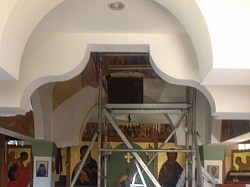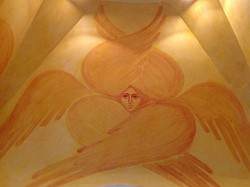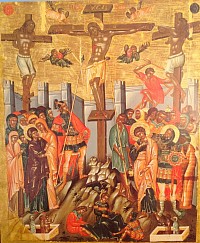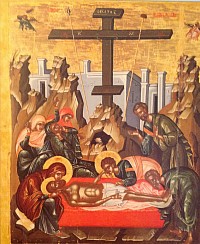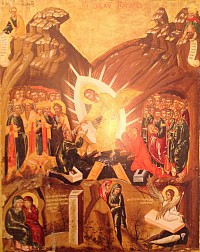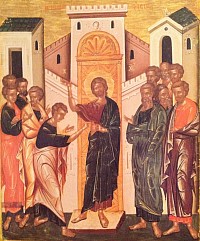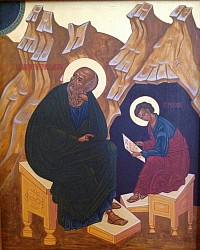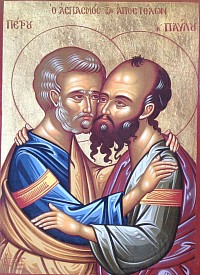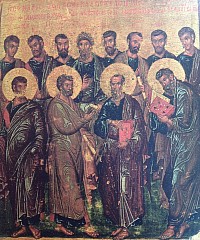Gallery
The Crucifixion
In his early thirties, Jesus of Nazareth was crucified under Roman Law by edict of Pontius Pilate (reluctantly it is believed) who had been placed in an impossible political position by the Pharisees and Sadducees. According to Roman Law, the crimes for which a prisoner was crucified were nailed on a board above their head. Because Jerusalem was a polyglot society, criminals had their crimes written in the three main languages of that society. Thus, Pilate had ordered that in Greek, Latin and Hebrew was written 'Jesus of Nazareth. King of the Jews'. Jerusalem was politically legally culturally and ethnographically cosmopolitan. It was this richness of population that deemed that we know Christ by His Greek Name (Jesus) and not by His Hebrew Name (Joshua Bar Joseph). His crucifixion took place on a Friday, and concern was raised that He wouldn't be dead by dusk on Friday, as that was the beginning of the Shabbes.
Jewish Law stipulated that there should be no one still alive on a cross by the time the Shabbes began. Jewish law forbids crucifixion, indeed, Jews revolted more than once when the Romans, within Judea, crucified people. Jewish law stipulates that, if a man is hung, his body is brought down by nightfall. Jewish law also stipulates that the dead are buried within 24 hours of death, and that no one is left unburied over Shabbos.
Crucifixion was a slow painful and lingering death, occasionally made easier by those compassionate enough in the crowd (often family members or friends) passing up a hypnotic drug contained in vinegar suspended in a sponge. Despite being offered a sponge, Jesus refused this aid. Death in this way placed enormous strain on the cardiac and pulmonary systems. As the arms are stretched by the weight of the body, the rib cage is impaired from movement leading to slow suffocation. To spread the torture and punishment out a little longer, prisoners had their ankles bound or nailed to a ledge upon which they could push themselves to help their breathing. This in turn added to their pain as they were pushing against the nails in their ankles. Eventually weakened by all this they died, sometimes days later. To avoid being left till after the Sabbath, Roman soldiers were instructed to break the bones to hasten death by preventing them from breathing longer. Unusually, Jesus had died by this time and the soldiers instead thrust a spear into his abdomen, from which fluid drained. This fluid is quite possibly a product of Congestive Heart Failure and Pulmonary Oedema caused by the crucifixion, where the heart being unable to pump effectively, backed up blood and fluid decreasing the volume of blood the heart could pump round, leading to fluid building up in the lungs.
The crucified were stripped naked to compound their humiliation, though Christian art applies modesty to the depiction. Everything possible was done to make the torture of crucifixion as cruel as possible. The condemned were made to carry the instrument of their death through the streets, witnessed by the crowds, outside the city walls to the place of execution. On the day in question, we know of two others who were crucified with Jesus. As the condemned were being prepared for death, it was a perk of the job for the soldiers on duty to divide the possessions the condemned among them.
In particular Jesus was stripped of his expensive seamless robe which was woven top to bottom and was identical to that worn by Priests serving in the Temple. It is unclear if it was the techelet, which was 12 ply sky blue dyed wool, or, possibly more likely, made of six ply woven white flax, the sort of robe the High Priest would have worn on the Day of Atonement. The High Priest would have two sets, one for use in the morning and one in the evening, and he only wore these once. The robe was a closed garment and slipped on over the head. The opening at the neck was round, with a hem that was doubled over and closed by weaving-not by a needle. The garment hung down in front and in back, and its length extended all the way down to the priest's feet. There is a difference of opinion as to whether there were sleeves, but if so these would also have been seamless and attached separately.
(Incidentally, this robe is akin to the same as the robe worn by patriarch Joseph but, due to an oft repeated mistranslation, was called a "coat of many colours", and was in fact white).
St Susanna the Myrrh Bearer
This Susanna refers to the Susanna mentioned in Luke's gospel chapter 8. This is the only time she is mentioned by name in the gospels, but it is assumed by the church that when 'The women' (Luke 23) came to anoint the body of Jesus, Susanna was one of them.
The crucifixion took place on a Friday, just before the beginning of the Jewish Shabbes (sabbath), and in accord with the strict traditions of the time there was no time to fulfill all the burial customs of Jewish Law. As such, Jesus was laid in a borrowed tomb to await the time after the Shabbes had ended for the burial customs to be completed. Thus it was that, at dawn on Sunday, a group of women arrived at the tomb laden with the necessary articles to complete the burial rites according to Jewish law and custom. Among the items necessary for this purpose was Myrrh.
The origins of this can be found as far back as Exodus (30:22-25, 32-33). Myrrh is a reddish resin that oozes and is dried from species of the genus Commiphora, which are native to northeast Africa and the adjacent areas of the Arabian Peninsula. Commiphora myrrha, a tree commonly used in the production of myrrh, can be found in the shallow, rocky soils of Ethiopia, Kenya, Oman, Saudi Arabia and Somalia. Thus, we know it was expensive as it had to arrive in Israel from across such lengthy trade routes. To make into oil this dried sap has to be distilled.
Arriving at the tomb, the 'myrhh-bearing women' (as they are usually called in Orthodox texts) found that the tomb was empty. It was thus not Jesus's male followers, but the women who had cared for him, who were the first witnesses of the resurrection, and in Orthodoxy this group of women have a far higher profile than in any strand of Western Christianity.
The Descent from the Cross
To avoid transgressing the rules of the Shabbes (they would have hurried home for the Sabbath meal because one does not mourn on the Sabbath) Jesus was taken down from the cross, wrapped in a linen shroud and taken to a tomb owned by a man named Joseph. In Orthodoxy we remember this at every liturgy, and at Pascha we mark the event by the sung words of "Noble Joseph,having taken down the body of Jesus from the cross, wrapped it in linen and spices and laid it in the tomb". At Pascha on Good Friday the church becomes the tomb and the altar the site of crucifixion, when during that service the shroud bearing the image of Christ is brought from the altar to the place laid out in honour and decorated with flowers as though Joseph himself, with the followers of Jesus, were bringing it themselves.
The congregation then honour this shroud and themselves lay flowers at His body. This practice follows on from a pre-Christian tradition centred in Cyprus & the Hellenistic world, that honoured the goddess Aphrodite/Venus. Pre-Christian communities would honour Aphrodite/Venus in Spring by decorating a table on which would be placed the image of Adonis to commemorate his death. Adonis was the human lover of the goddess Aphrodite/Venus who annually was allowed to bring him back to life. Plants used were Myrtle, (symbolising beauty and your), the Dog Rose, (because it is associated with her tears or her blood), Anemone and Adonis Annua, (representing the blood of Adonis).
As Christianity spread across the world, pagan rites and practices were adopted by clergy and missionaries to enfold cultures into Christianity. This in many way is why Mary hold the position she does in Christian tradition. The cult of Mary is simply a reflection of how Christianity enfolded old religions worshipping fertility goddesses into the Christian perspective so as to make it easy for pagans to be converted. Acts 17:16 - 34 describes how Paul preached to Athenians about how their worship of the "Unknown God" was actually the God who we know to be the God of Abraham, Isaac and Jacob.
In Israel, the needs of the Sabbath were such that Joseph and those with him had to hasten home to observe the Shabbes meal, the same meal that is celebrated every Friday in Jewish homes everywhere, before they could do more for Jesus to fulfill the Jewish rituals of care for the dead. These rituals, involving oils and prayers, would have to wait till the Sabbath was over, one hour after sunset Saturday night. It was unlikely that they would have wanted to attend the body of jesus in the dark, and also it is possible the city gates were closed from sunset Saturday until sunrise Sunday, preventing them doing this.
Descent into Hell (the Resurrection)
Both the Apostles' and the Athansaian Creed state that following His death, Jesus descended into the place of the dead, Hades. The Orthodox services at Pascha (Easter) strongly stress the way in which "trampling down death by death" Christ bestowed life on those in the tombs, and the ikon shows some of the most important of those in the tombs - including Adam and Eve - being freed from death. This indicates that the whole of humanity - those who lived before Christ as well as those who lived after Him - are the beneficiaries of his life, death and resurrection.
St Thomas
St Thomas, or Didymus, is recorded as doubting sceptically the Resurrection. Jesus appeared to the Apostles and invited Thomas to touch the wounds to provide evidence enough for Thomas to believe. Thomas is reported to have been so convinced, that in AD 52 he travelled as far as Kerala in India to bring news of the Messiah to the Jewish community there who were part of the Diaspora. By all accounts he was a charismatic figure and throughout that part of the world grew communities which followed Christianity. He is believed to have died AD 72 on 21st December.
The Ascension
Christian Theology asserts that forty days after the resurrection Christ ascended into Heaven. It is central to Christian belief and is included in all the Creeds. Forty days echo the forty days in the wilderness. It must be remembered however, that in Jewish literature the term forty days is often used to denote 'a long period of time' and not necessarily intended to depict an exact period of chronology.
St Mark
Traditionally believed to have been born in Cyrene in what is now Libya, the year of his birth is unknown. Commentators record he was John Mark, John being the Jewish component of his name and Mark being the name to which he answered after joining Christ as a disciple. It is believed his mother was an eager follower of Christ, and opened her house for use after the resurrection. Some believe that it was her house in which the Last Supper was held. He travelled widely to places including Egypt, Libya and Pentapolis. He became the first bishop of Alexandria in Egypt, and it was in Alexandria that pagans tied a rope round his neck and dragged him to his death. Mark is one of the leading saints in the Coptic Orthodox tradition.
He is traditionally believed to be the author of the gospel that bears his name, having based his knowledge on what he had heard from the Apostle Peter. Mark served as an assistant to Barnabus and Paul on their travels. The term denoting assistant hupereten is rather vague and we don't know in what capacity he helped. Later he is seen as a companion to Paul and later still with Peter. A lot of what we have recorded about Mark is either vague or contradictory by comparison to what we know of other prominent figures. Early sources link him to being a Jewish Priest as he came from the line of Levi. Eusebius and Adamantius remark that Mark wasn't actually a member of the disciples at all, yet later tradition allocate Mark to being one of the 72 disciples. Hyppolytus and others refer to Mark being "stump fingered", the belief being that Mark mutilated is fingers to make him unfit to continue to perform Priestly duties. The exact year of his death is also vague, but the best guess is around AD 68.
St Matthew
Matthew, a tax collector, possibly for Herod Antipas, and originally named Levi, was recruited by Jesus and became one of the Apostles. He was born in Galilee, which at the time wasn't part of the Roman province Idaea or Judea. Matthew collected taxes for the Romans and became, like his colleagues, fairly despised. Tax collectors were not paid. They paid to the government a set amount, and whatever they collected above this was their payment. Therefore, it was in their interest to collect as much as they could, to get as rich as they could. Similarly, prefects such as Pontius Pilate were required to remit a certain sum to Rome and whatever they could collect over and above this was profit. It is obvious why Matthew was an outcast.
Matthew would have had to be literate in both Aramaic and Greek to do his job, so he must have been a literate intelligent man. In what today is Algamor, Jesus called Matthew and joined him for a meal. Ever critical of Jesus, the Scribes and Pharisees took Jesus to task for eating with Matthew as he was deemed by his profession to be automatically a sinner and outcast. Jesus was crushing in His reply by saying He didn't come to call the righteous but sinners.
Scholarly opinion is divided as to whether Matthew was the author of the gospel named after him. What is known is that Matthew, a witness to the ascension, travelled far afield to proselytise and it could well be that some, if not all, of his gospel was written by him, or at least one of his followers. He is said to have died in Ethiopia under the edict of Fulvian, who had him burnt alive, though other sources would have us believe he was stoned to death or beheaded.
St Luke
Luke is probably an abbreviated version of the name Lucanus, a name unknown before the 1st Century. Luke was a probably a Greek Gentile and not a born Jew, although he had a wide knowledge of the Septuagint either as a Jewish proselyte, or after he became Christian. Luke came from the city of Antioch in Syria, which at the time was heavily under the influence of Greek thought. He is believed to have been a physician (i.e. not a surgeon but one that prescribed medicine) and was widely travelled, quite possibly working as a doctor aboard ships. He was a bachelor and a disciple of Paul. It might have been the case that at some point he had a residence in Troas, though this is not clear. As a doctor, like Matthew, he would have been an intelligent and literate man. It's commonly held that he was the author of the gospel that bears his name and also the Acts of the Apostles, and he probably had a hand in some of the authorship of Hebrews, but in truth this cannot be conclusively concluded. The earliest manuscript copy of the gospel can be dated to AD200 and it is the attribution attached to this that has designated Luke to be the author. After the death of Paul, he is believed to have travelled to Italy, Dalmatia, Macedonia, and other regions.
He is believed to have died at 74 or 84 in Thebes, in the region of Boeotia, Greece. It is believed he was tortured then hanged from an olive tree.
Saints John the Theologian and St Prochor
St John the Theologian refers to the Apostle John, writer of the fourth gospel. The youngest of the apostles and possibly closest to Jesus. His parental attribution is said to be Salome his mother (who, tradition has, was one of those who arrived with myrrh to anoint Jesus after the crucifixion) and Zebedee, a fisherman. A James was his younger brother. There was an especially close relationship between John and Jesus which is acknowledged often in the gospels. One can only speculate why Jesus referred to the pair collectively as "Boanerges" (translated "sons of thunder") but fiery tempers seems to be the obvious one.
He is often thought to be to be the same John who is referred to as John the Evangelist and John of Patmos. Tradition indeed ascribes John as being the author of one gospel, three epistles and the book of Revelation, however, since as early as AD 600 there have been doubts that the same person wrote all five documents with John the Elder being thought of as the author of two of the epistles and the Revelation being considered as the work of Justin Martyr and Irenaeus. Modern scholars, upon examination of the style, grammar and vocabulary, strongly suggest that the three Johns mentioned above are in fact three different people. The dating of the gospel has received much attention, from it being written between AD 65-85, to maybe being written as late as Ad 90-100.
Tradition is divided as to whether he died in Jerusalem or on Patmos, but, however the dominant theory is that he ended his days exiled by Diocletian on the island of Patmos around AD 90-95, where it is said he received the series of visions set out in the Book of Revelation.
St Prochor is believed to be the name of a pupil and companion, who, it is said, spent much of his time writing down what John needed him to record and assisting him in his infirmity.
Ikon above the Royal Doors
Along the top of the ikon screen in our church are a series of Ikons that depict scenes from the life of Christ and of his mother. This particular ikon, in the centre of the row, depicts not an event, however, but Jesus in the company of figures who hold special significance in the New Testament narrative. Jesus is the central figure and is shown seated on a throne holding the words I AM. This term is first seen in Exodus when we read "and God said to Moses, I AM that I AM, and He said, This will you say to the Children of Israel, I AM has sent me to you" וַיֹּ֤אמֶר אֱלֹהִים֙ אֶל־מֹשֶׁ֔ה אֶֽהְיֶ֖ה אֲשֶׁ֣ר אֶֽהְיֶ֑ה וַיֹּ֗אמֶר כֹּ֤ה תֹאמַר֙ לִבְנֵ֣י יִשְׂרָאֵ֔ל אֶֽהְיֶ֖ה שְׁלָחַ֥נִי אֲלֵיכֶֽם׃. The key point of this ikon is it emphasises the link to Jesus being the fulfilment of the Law and the Prophets, the promise to the people of Israel. The people depicted who surround Him, from left to right, Saint Peter, the Archangel Michael, Mary the Mother of God, John the Forerunner and Baptist, the Archangel Gabriel, and St.Paul.
Saints Peter and Paul
Peter and Paul are central to the spread of Christianity after Jesus death and resurrection.
Peter was the son of Jona and was born in Bethsaida in Galillee, (where also St Philip lived) he was an apostle alongside his brother Andrew and is remembered as the first bishop of Rome. By the time he met Jesus he was married and living with his wife and mother in law in Capernaum. He was a wealthy man who owned his own boat. He was influenced by the message of John the Baptist and was thus ripe for when Jesus called him. Subsequent to the Ascension Peter returned to Jerusalem and became a prominent character in the community of Jesus' followers, taking the lead in spreading the message. In time he left to spread the message further afield, most particularly in Lydda, Joppa and Caesarea before returning to Jerusalem. There he resumed his position at the head of the Christian community till the arrival of the first Herod Agrippa AD 42-44. Herod set about a persecution of Christians and laid Peter in prison intent upon his execution. Peter escaped and left the area, leaving the Jerusalem community in the hands of James, but little is known where exactly he went. In the second year of the reign of Emperor Claudius he went to Rome and overthrew Simon Magus to hold the Bishops position till his death under Emperor Nero The date of his death by martyrdom isn't known, but various scholars have narrowed it down to AD 64-68. The place of his death is said to be the site of the Neronian Gardens where now the Vatican stands. Emperor Nero was a particularly sadistic executioner, and these gardens were is particular playground of cruelty. Tradition holds that Peter died by upside down crucifixion. Peter wrote two epistles, and the Gospel of Mark is also ascribed to him (Mark was his disciple and interpreter).
Paul is so well known, it is almost redundant to say more. He was what would now be termed a Turk, being born in Tarsus, and was, before his conversion, an enthusiastic Pharisee devoted to the destruction of Christianity. He was born in Tarsus in Cilicia, of pious Jewish parents. He was named Saul as he was a descendant of the Tribe of Benjamin in memory of the first King of the Jews. As a young man he studied in Jerusalem under Gamaliel His trade was that of making tents, or rather, making the mohair from which tents were made.
He was active and determined to persecute those preaching Christianity, and he is believed to have cheerfully and helpfully acted as cloakroom attendant so that those who wanted to stone Stephen to death could do so unimpaired. He dragged people from their homes who he believed to be Christian and had them tortured and killed. His conversion however, was dramatic and sudden and he became as zealous a follower of Jesus as he had been an opponent.
He was responsible for much of the development of Christianity in and around the Mediterranean Basin. After the death of Jesus, both Paul and James took the dominant role in influencing what was to become Christianity. James adhered fairly closely to the Judaic traditions in his thinking, whereas Paul had different ideas. Through his influence, he relaxed the Judaic expression of Christianity and made it easier for Gentiles to be welcomed into this new religion. James took the line that to follow Jesus, being a devout Jew, automatically meant that believers should believe what Jesus believed and to stick to the way of life that Jesus embraced. There was lack of enthusiasm among Gentiles to the full extent of this message, particularly to circumcision, which is where Paul's message succeeded. Paul saw that to sell the message of what was later called Christianity, those spreading the message had to take a less rigid line on certain things. As such his influence on Christian thinking and attracting believers cannot be underestimated. He died as a martyr in Rome around AD 62-64.
He remained faithful and observant to the Torah throughout his life, taking to a Mikvah after he converted and stating that Gentiles should obey the commandments set out in the Torah. He continued to make Jewish sacrifices in the Temple throughout his ministry and continued to keep the Jewish Festivals. So rather than turning his face from his tradition of Judaism towards Christianity, he continued living the Jewish life and sought Gentiles and fellow Jews to follow the example of Jesus, who Himself was a Jew and Who besought people to obey the commandments.
The Feast day of both saints is marked on June 29th
Synaxis of the Twelve Apostles
This ikon presents the twelve apostles. Peter, Andrew, James (son of Zebedee) John, Phillip, Bartholomew, James (son of Alphaeus) Thomas, Matthew, Simon, Mark, Thaddeus and Paul who replaced Judas in ikonographic portrayal.
Of the apostles, Peter, Andrew, James, John, and possibly Philip were commercial fishermen. Much has been said of these that Jesus chose "poor fishermen", but this isn't borne out by archeology. Far from being poor, it is quite probable that Peter, Andrew, James and John were in fact wealthy men. To be a commercial fisherman in 1st Century Israel meant that they would have had at least one boat, possibly more, and each boat would have needed an employed crew of at least nine. Archeology has determined that commercial fishing boats were large vessels crewed by eight oarsmen. This meant that they would have been navigated by one other and possibly had yet others to work the catch. This makes Peter, Andrew, James and John well off business men with a social status far higher than many have attributed to them. This explanation at least accounts where much of the money came from which Jesus and the disciples needed to conduct their mission.
In the same vein, Jesus, being a carpenter and the son of a carpenter, was also far from being a poor man. Carpenters in the First Century were the engineers of society. It were carpenters who built and repaired houses, synagogues, bridges etc. These were skilled people and far from just making the odd door or bowl, Jesus and Joseph would have been able to command a good income from their work.
Neither Jesus nor the apostles were a ragged rough rag-tag & bob-tailed crew of "rude mechanicals" as many would have us believe. Their social status was pretty high amongst their contemporaries, Middle Class even, and this was necessary because Jesus need to have people around Him to whom other people would pay attention.
The author of Mark's gospel (quite possibly Peter) describes how Jesus called 'Levi the son of Alphaeus' to His side, and he is described as a tax collector. After this entry Levi is never heard of again, and no explanation is given why he disappears. The same writer later introduces Matthew and James as being both sons of Alphaeus, though it isn't clear if this is the same Alphaeus or not. The author of Matthew's gospel makes the point that Matthew was also a tax collector, which seems dubious but does resolve "a little difficulty" leaving the rest of us to assume Levi and Matthew were one and the same. Tax Collectors, though they held a social status within the hierarchy of the Roman State, were however despised by their own people. The reason for this is simple. Rome decided how much money they wanted from the Tax Collectors and left it up to these individuals themselves how they collected it and how much they took from the people. If they extracted more than Rome wanted they could keep the surplus. Rome wasn't interested if there was a little corruption going on, just as long as they got the money they decided was their due.
Simon the Zealot belonged to a group of political activists and agitators who were intent upon inciting the Israelites into open and bloody revolt against the Romans. The Zealots were a small but vocal group who alongside the Pharisees, the Sadducees and the Essenes, (of which it is fairly certain that much of Jesus thinking was influenced by the Essenes) formed the main groups which influenced Jewish society at the time. The most violent of the Zealots were called the Sicarii, who not only were violent towards Romans, but also fellow Jews whom they believed were collaborators. In time they were to take a leading role in the AD 66 Jewish Revolt which, for four years, held power over Jerusalem till Titus Flavius retook the city and destroyed the Temple. We are not told what qualities Simon had that attracted Jesus to invite Simon into his inner circle, but there is plenty of scope for speculation, but whatever the reason behind it we can be sure it wasn't an arbitrary whim.
